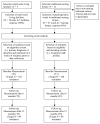The effects of small-scale, homelike facilities for older people with dementia on residents, family caregivers and staff: design of a longitudinal, quasi-experimental study
- PMID: 19154579
- PMCID: PMC2637879
- DOI: 10.1186/1471-2318-9-3
The effects of small-scale, homelike facilities for older people with dementia on residents, family caregivers and staff: design of a longitudinal, quasi-experimental study
Abstract
Background: Small-scale and homelike facilities for older people with dementia are rising in current dementia care. In these facilities, a small number of residents live together and form a household with staff. Normal, daily life and social participation are emphasized. It is expected that these facilities improve residents' quality of life. Moreover, it may have a positive influence on staff's job satisfaction and families involvement and satisfaction with care. However, effects of these small-scale and homelike facilities have hardly been investigated. Since the number of people with dementia increases, and institutional long-term care is more and more organized in small-scale and homelike facilities, more research into effects is necessary. This paper presents the design of a study investigating effects of small-scale living facilities in the Netherlands on residents, family caregivers and nursing staff.
Methods and design: A longitudinal, quasi-experimental study is carried out, in which 2 dementia care settings are compared: small-scale living facilities and regular psychogeriatric wards in traditional nursing homes. Data is collected from residents, their family caregivers and nursing staff at baseline and after 6 and 12 months of follow-up. Approximately 2 weeks prior to baseline measurement, residents are screened on cognition and activities of daily living (ADL). Based on this screening profile, residents in psychogeriatric wards are matched to residents living in small-scale living facilities. The primary outcome measure for residents is quality of life. In addition, neuropsychiatric symptoms, depressive symptoms and social engagement are assessed. Involvement with care, perceived burden and satisfaction with care provision are primary outcome variables for family caregivers. The primary outcomes for nursing staff are job satisfaction and motivation. Furthermore, job characteristics social support, autonomy and workload are measured. A process evaluation is performed to investigate to what extent small-scale living facilities and psychogeriatric wards are designed as they were intended. In addition, participants' satisfaction and experiences with small-scale living facilities are investigated.
Discussion: A longitudinal, quasi-experimental study is presented to investigate effects of small-scale living facilities. Although some challenges concerning this design exist, it is currently the most feasible method to assess effects of this relatively new dementia care setting.
Figures
Similar articles
-
[Small-scale, homelike care environments for people with dementia: effects on residents, family caregivers and nursing staff].Tijdschr Gerontol Geriatr. 2013 Dec;44(6):261-71. doi: 10.1007/s12439-013-0044-2. Tijdschr Gerontol Geriatr. 2013. PMID: 24203378 Dutch.
-
Dementia care redesigned: Effects of small-scale living facilities on residents, their family caregivers, and staff.J Am Med Dir Assoc. 2010 Nov;11(9):662-70. doi: 10.1016/j.jamda.2010.08.001. J Am Med Dir Assoc. 2010. PMID: 21030001
-
Small-scale, homelike facilities in dementia care: a process evaluation into the experiences of family caregivers and nursing staff.Int J Nurs Stud. 2012 Jan;49(1):21-9. doi: 10.1016/j.ijnurstu.2011.07.008. Epub 2011 Aug 5. Int J Nurs Stud. 2012. PMID: 21820656
-
"There's No Place Like Home": A Scoping Review on the Impact of Homelike Residential Care Models on Resident-, Family-, and Staff-Related Outcomes.J Am Med Dir Assoc. 2016 Aug 1;17(8):685-93. doi: 10.1016/j.jamda.2016.03.009. Epub 2016 Apr 26. J Am Med Dir Assoc. 2016. PMID: 27130574
-
Small, homelike care environments for older people with dementia: a literature review.Int Psychogeriatr. 2009 Apr;21(2):252-64. doi: 10.1017/S104161020800820X. Epub 2008 Dec 23. Int Psychogeriatr. 2009. PMID: 19102801 Review.
Cited by
-
Research on the Aging-Friendly Kitchen Based on Space Syntax Theory.Int J Environ Res Public Health. 2022 Apr 28;19(9):5393. doi: 10.3390/ijerph19095393. Int J Environ Res Public Health. 2022. PMID: 35564786 Free PMC article.
-
Living at the farm, innovative nursing home care for people with dementia - study protocol of an observational longitudinal study.BMC Geriatr. 2015 Nov 2;15:144. doi: 10.1186/s12877-015-0141-x. BMC Geriatr. 2015. PMID: 26527159 Free PMC article.
-
Palliative care in small-scale living facilities: a scoping review.BMC Geriatr. 2024 Aug 24;24(1):700. doi: 10.1186/s12877-024-05259-9. BMC Geriatr. 2024. PMID: 39182044 Free PMC article.
-
Small-scale, homelike facilities versus regular psychogeriatric nursing home wards: a cross-sectional study into residents' characteristics.BMC Health Serv Res. 2010 Jan 29;10:30. doi: 10.1186/1472-6963-10-30. BMC Health Serv Res. 2010. PMID: 20113496 Free PMC article.
-
Special care units and traditional care in dementia: relationship with behavior, cognition, functional status and quality of life - a review.Dement Geriatr Cogn Dis Extra. 2013 Oct 5;3(1):360-75. doi: 10.1159/000353441. Dement Geriatr Cogn Dis Extra. 2013. PMID: 24403908 Free PMC article. Review.
References
-
- Verbeek H, van Rossum E, Zwakhalen SMG, Kempen GIJM, Hamers JPH. Small, homelike care environments for older people with dementia: an overview of the literature. International Psychogeriatrics - PubMed
-
- Briller SH, Calkins M. Defining Place-Based Models of Care: Conceptualizing Care Settings as Home, Resort or Hospital. Alzheimer's Care Quarterly. 2000;1:17–23.
-
- Marshall M, Archibald C. Long-stay care for people with dementia: recent innovations. Reviews in Clinical Gerontology. 1998;8:331–343. doi: 10.1017/S0959259898008466. - DOI
Publication types
MeSH terms
LinkOut - more resources
Full Text Sources
Medical


